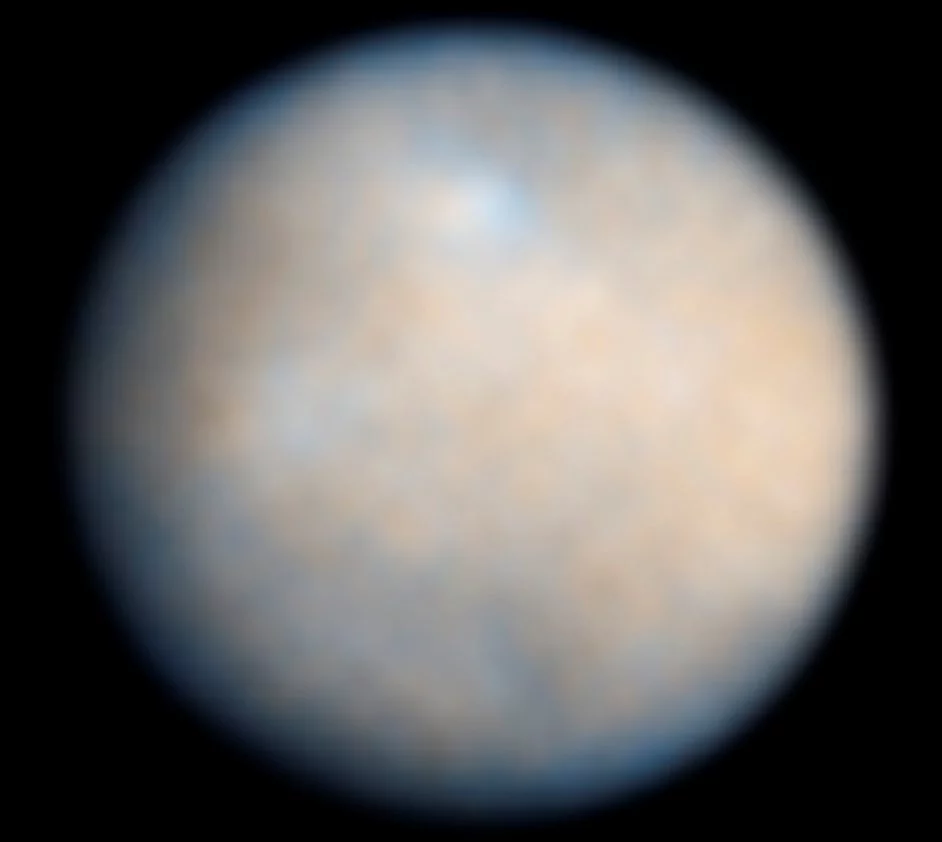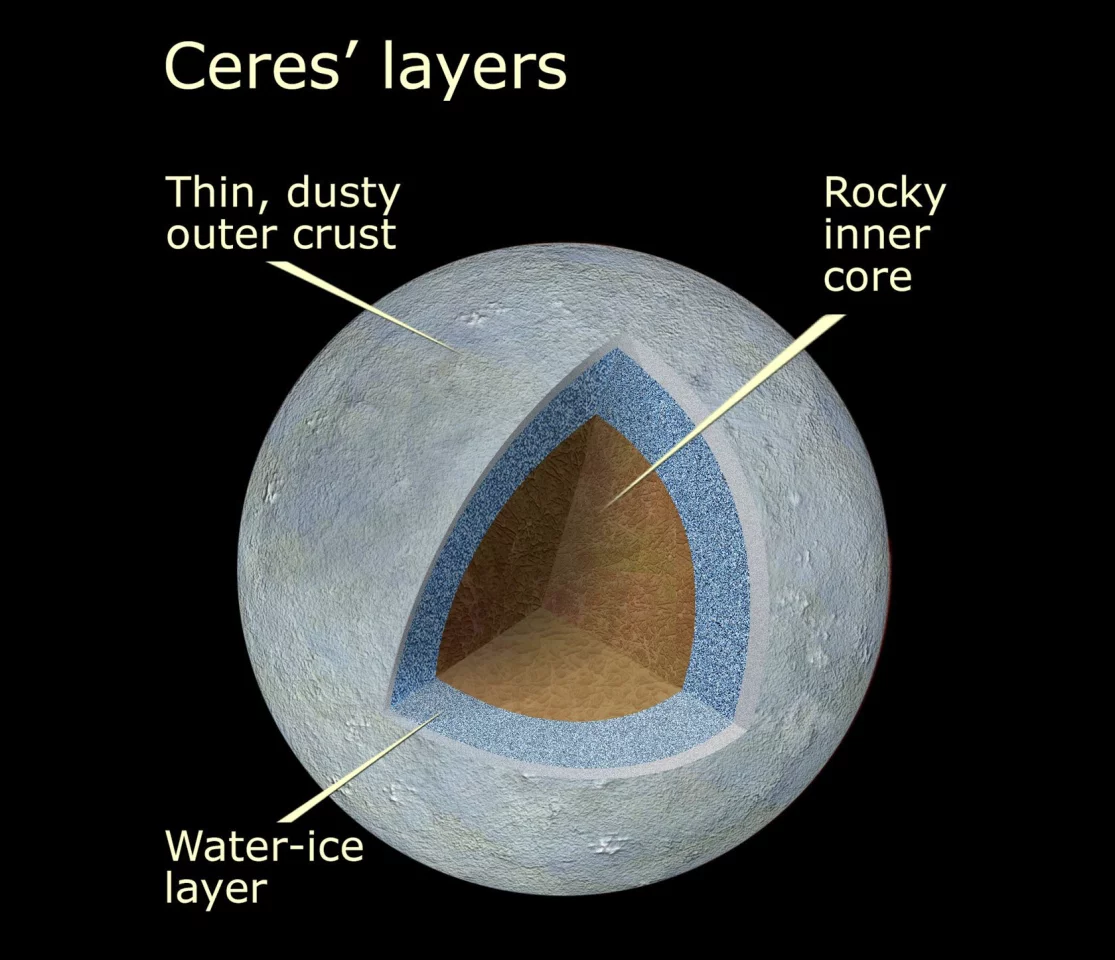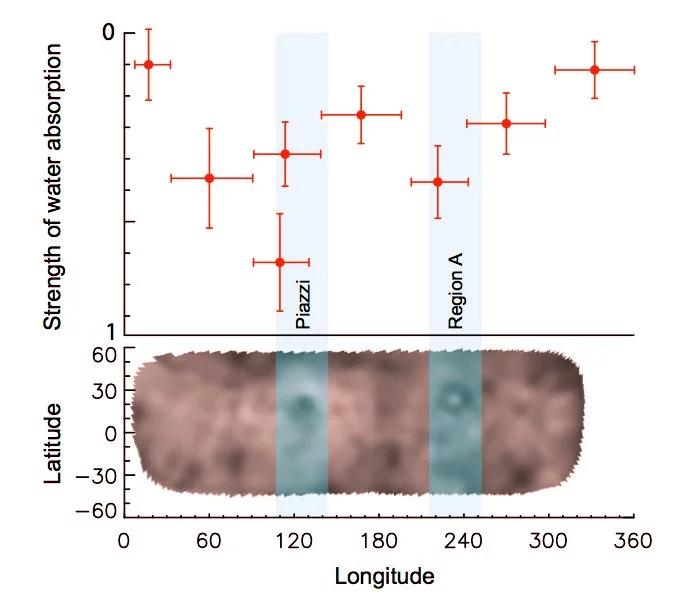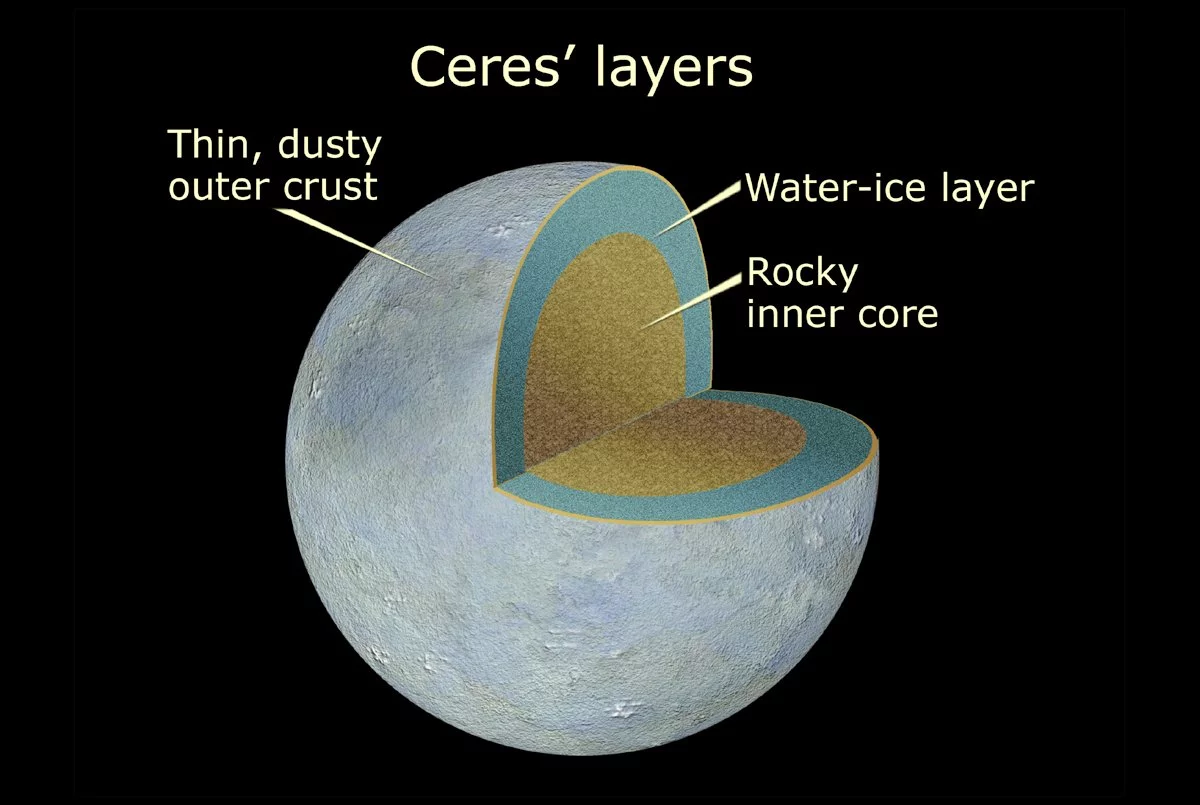In mid-2015, the asteroid probe Dawn is scheduled to establish orbit around Ceres, the only dwarf planet in the inner Solar System, as well as the largest asteroid, to begin roughly six months of close-up observation. The level of interest in this mission has significantly increased with the detection by the ESA's Herschel space observatory of plumes of water vapor being exuded from Ceres' surface from a pair of local sources.
Ceres is a Solar System body 950 km (590 miles) in diameter. Orbiting the Sun every 4.6 Earth years at an average distance of 2.77 Astronomical Units (AU), it contains about one-third of the total mass of the asteroid belt, making it the largest object between Mars and Jupiter.

It is a slightly oblate spheroid in shape, which appears to be in hydrostatic equilibrium with its gravity, which is the feature that makes Ceres a dwarf planet. Indeed, the only dwarf planet in the asteroid belt, although Vesta and Pallas are potential candidate dwarf planets. These three asteroids all appear to be protoplanets left over from the formation of the planets some four and a half billion years ago.
The details of Ceres' shape reveal some of its history and composition. Its shape is oblate, but rather less so than if its composition were homogeneous throughout the object. Instead, studies have shown that Ceres' shape is more representative of a body with a dense core and less dense crust.

This has led to the model shown above, wherein Ceres has a rocky core about 750 km (465 mi) in diameter covered by a 100 km (62 mi) thick layer of ice. The lot are then covered by a thin layer of whatever debris has settled on Ceres' surface over the last four billion years. Ceres may have accumulated its horde of ice by originating further out from the Sun, and only later settling down into its present orbit by interacting with the giant planets once they were formed.
It is interesting to note that if this model is even close to reality, there is more water on Ceres than there is fresh water on Earth. A base on Ceres may be a must for the future of space exploration, colonization, and industry.
One of the last efforts of the European Space Agency's Herschel Space Observatory was to finish a series of observations of Ceres carried out on three prior occasions in 2011 and 2012 with a 10-hour period of observation on March 6, 2013, just a month and a half before Herschel ran out of the coolant required for its operation.
The observations focused on the question of water vapor in the region immediately surrounding Ceres, as measured by Herschel's Heterodyne Instrument for the Far Infrared (HIFI). A strong absorption line of water vapor at a frequency of about 557 GHz (a wavelength of about 538 microns) was monitored, with the intent that the absorption could be seen as a dark line in the continuum thermal emission from Ceres' surface.
Clear evidence for the presence of water vapor on Ceres was detected in the 2012 and 2013 observations when Ceres was nearing its closest approach to the Sun (2.56 AU), but not in the 2011 observations when Ceres had just passed its furthest point from the Sun (2.98 AU). This suggests (but is far from proving) that one of the key variables determining the amount of water vapor on Ceres may be the intensity of the Sun's light on its surface.

In addition to the long-term variability in the amount of water vapor detected, the data in the figure above shows that the amount varied within a single Ceres day (9.1 hours). Two peaks appear in the water vapor absorption spectrum, which correspond to the first definite surface feature on Ceres, named Piazzi after the discoverer of Ceres, and a feature designated "Region A" on a list of 11 albedo-based surface features identified by a Hubble study in 2003-4.
It seems likely that these surface features are the main sources of water vapor on Ceres. Based on the depth of the water vapor absorption line, each of the two main sources are producing about 3 kg (6.6 lb) of water vapor per second; not a large amount when spread over an entire planet, even a dwarf planet. Indeed, this level of sublimation, if driven by exposure to the Sun's light, requires less than a square kilometer of exposed ice to be at the dwarf planet's surface.

Another possible source for the water vapor could be ice volcanoes, as found on Triton and Enceladus (photo above) and possibly other icy moons in the Solar System. As Ceres is not subject to significant tidal stresses, the source of power for ice volcanoes would likely be radioactives trapped in the inner rocky core.
At present there is insufficient information to choose between these two scenarios, although the absence of water vapor absorption in 2011 (when Ceres was cooler than in 2012 and 2013, owing to its eccentric orbit) makes the evidence for solar-powered sublimation a bit stronger.
The remaining question is where does the water vapor go? The integrated amount of water vapor within about 1,500 km (1,000 mi) of Ceres' surface is in the order of 10 tons (9 tonnes), which is only about half an hour's production.
Most of the water vapor probably escapes into space. The ESA study found that about 97 percent of the water vapor is traveling fast enough to escape from Ceres' gravitation pull (Ceres' escape velocity is only 0.52 km/s (1,160 mph).) Three percent of the water vapor is moving sufficiently slowly that it falls back to the surface, and another seven percent returns to Ceres' surface following scattering off other water vapor molecules. In the end, about nine-tenths of the water vapor escapes, and most of the remainder refreezes on Ceres. The ten tons in Ceres' exosphere is just the water that hasn't yet escaped or frozen out.
Dawn will be approaching Ceres in a bit more than a year, at which point Ceres will be approaching aphelion, the part of its orbit furthest from the Sun. It will orbit and study Ceres for a planned period of about six months, at which point Ceres will not quite have reached aphelion.
If the lack of water vapor in the 2011 observation is indicative of solar-driven sublimation as the source of the water vapor, Dawn may find little direct evidence of its existence, but is likely to find indirect evidence for the sublimation process. If ice volcanoes are the source, however, Dawn will be able to solve the mystery. Dawn carries imaging cameras to investigate surface structures, and can analyze the composition of the surface using both its near infrared and visible spectrometer, and the gamma ray and neutron detector.
The Herschel study has identified Ceres as the first (and so far, only) asteroid associated in any manner with water. The details are not yet clear, but if water is easily accessible on Ceres' surface, it will be an invaluable resource for the future of space exploration and industry.
Source: European Space Agency







